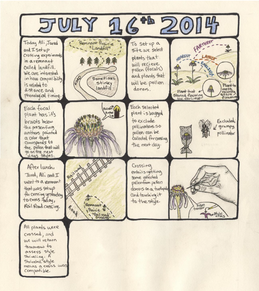We spent the morning working on our personal projects. Elizabeth assessed style shriveling on her crossed flowers at Yellow Orchid Hill, where, she reports, flowering has recently passed its peak. Meanwhile, Claire and Jared performed crosses on the focal plants on the west unit of Staffanson. In P1, Will worked on his pollen preservation experiment and the Pollinator Posse (Keaton, Maureen, and Jennifer) surveyed P1 phenology. Further afield, Alli continued her flowering community analysis.
But the real action was at Hegg Lake, where I finished my first round of aphid additions to Echinacea angustifolia, E. pallida, and their hybrids in P7. I have almost doubled my efficiency since starting the additions, performing 20 additions in a little over an hour. I also surveyed the phenology of the 18 E. pallida flowering in the restoration nearby. Aphid survival and flowering phenology may seem pretty disparate topics–and they are–but they both inform our understanding of the consequences of introducing a non-native but closely related Echinacea species. Do they support the same aphids? How about their hybrids? How likely are they to hybridize? How much does their flowering phenology overlap? It’s hard to stick to just one question.
Doubtless inspired by my example, the rest of the team came to Hegg in the afternoon, where we measured plants in P2. Many of us we were able to increase our efficiency by working alone instead of in pairs, and row by row we progressed eastward. Less than an afternoon’s work remains.

